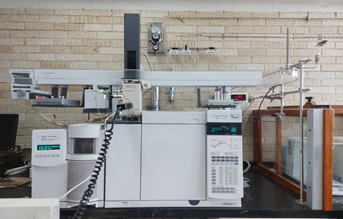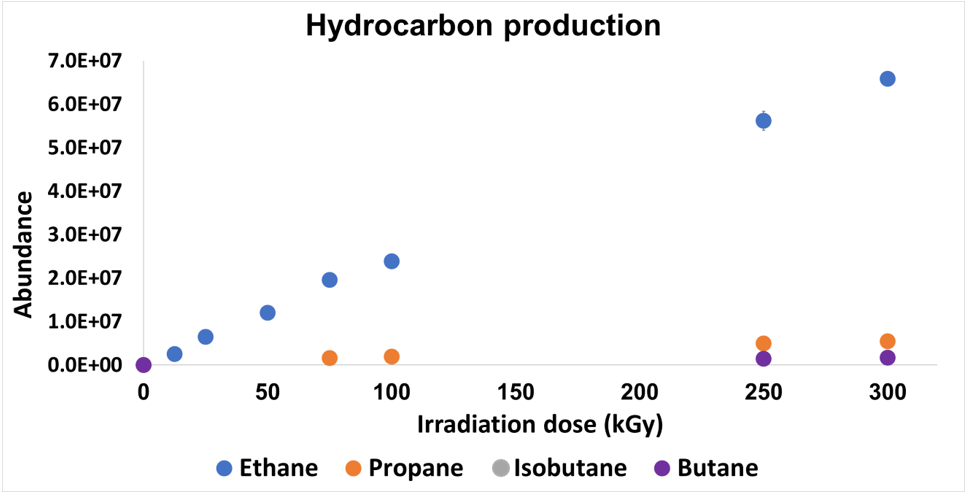Study of the incidence of gamma radiation on a simulated atmosphere of Titan: An experimental approach
- 1Science Faculty, National Autonomous University of Mexico, Mexico City, Mexico (rodrigo.zam198@gmail.com)
- 2Institute of Nuclear Sciences, National Autonomous University of Mexico, Mexico City, Mexico
Introduction
Titan, with a radius of 2,575 km is the second largest satellite of the Solar System, and the largest satellite of Saturn. Titan is the most Earth-like body in the Solar System, because has a moist climate with an active weather cycle (involving methane and perhaps ethane), a stable surface liquids, and a thick atmosphere [1] mainly composed of nitrogen and methane, in which they are carried various physical and chemical processes due to the energy sources that act on it, therefore its study will help us understand organic chemistry of planetary atmospheres [2,3].
The photochemistry in Titan’s atmosphere begins with the dissociation and ionization of the main atmospheric components by external energy sources such as Solar UV, Saturn's magnetosphere, solar wind and galactic cosmic rays. The identity and characteristics of this energy sources is important because, among other things, this determines the influences in the chemistry of the entire atmosphere and the surface of the satellite [2,3].
Based on this, in this work we experimentally study the possible effect that the incidence of cosmic rays would have on the chemistry of Titan's atmosphere. To emulated this process, Titan's simulated atmosphere was subjected to different doses of gamma radiation. Preliminary results show that gamma radiation forms saturated, linear and branched hydrocarbons (ethane, propane, butane and isobutane, etc); however, the presence of nitriles and aerosols has not been identified.
Materials and methods
The simulated atmosphere of Titan (10% methane in nitrogen) is prepared using a gas mixer (Linde FM-4660). The two gases used are from the Linde brand and with a high degree of purity; for nitrogen, the purity was 99.998%, while that of methane was 99.97%. Subsequently, the gas mixture is introduced into a Pyrex glass reactor with a capacity of 1 L, reaching a pressure of 1000 mbar with the help of a Schlenk line (Fig. 1).
Figure 1. Gas mixing and Schlenk line for the simulation of planetary atmospheres. Credit: [4]
To emulate the process of cosmic ray incidence, the simulated Titan’s atmosphere was subjected to different doses of gamma radiation (from a minimum dose of 12.5 kGy to a maximum dose of 300 kGy), which is generated by cobalt 60Co sources at the Irradiation Unit of the Institute of Nuclear Sciences of the UNAM (Fig. 2). For each irradiation dose, five replicates were carried out.

Figure 2. Irradiation of the simulated atmosphere of Titan.
After the irradiation, the compounds generated are separated, identified and quantified using an instrumental technique, comprising a gas chromatograph (GC) (Agilent Technologies 7890A) coupled to a mass spectrometer (MS) (Agilent Technologies 5975C) (Fig. 3). Each analysis began at 50°C with a five minutes isotherm, then there was a temperature ramp of 10 °C per minute until reaching a final temperature of 240 °C, maintaining these conditions until the end of the analysis time, which was 30 minutes.

Figure 3. Coupled Gas Chromatography and Mass Spectrometry System.
Results and discussion
Results show that gamma radiation forms linear and branched saturated hydrocarbons have been identified (ethane, propane, isobutane and butane) (Fig. 4 & Table 1), without the presence of aerosols. The first hydrocarbons to appear is ethane, from the lowest dose of 12.5 kGy, then propane appears at 75 kGy and finally isobutane and butane at 100 kGy. From this irradiation dose, the four compounds are present, increasing their abundances.
Figure 4. Chromatogram of the simulated atmosphere of Titan after irradiating at 300 kGy.
Table 1. Production of compounds by gamma radiation
After the identification of the main hydrocarbons generated, the formation rates were determined for each compound and with the flow of cosmic ray energy received by Titan's atmosphere (9.0 x 10-3 erg cm-2 sec-1) [5], the formation rate of these compounds per year was preliminarily calculated due to the incidence of cosmic rays ((Fig. 5 & Table 2)).
}
Figure 5. Abundance curve of compounds generated by gamma radiation. The lack of data between irradiation doses of 100 - 250 kGy is because at the time of writing this work, those samples have not yet been analyzed.
Table 2. Preliminary production rate of compounds by gamma radiation.
Conclusion.
Gamma radiation favors the formation of linear, saturated and branched hydrocarbons, but not unsaturated, aromatic, nitrile hydrocarbons or aerosols. In addition, the main hydrocarbon formed by this energy source is ethane, followed by propane, isobutane and finally butane.
These preliminary results are relevant to understanding the possible dynamics and chemistry that would take place in the lower part of Titan's atmosphere, since this zone is where cosmic rays would have the greatest effect.
References.
[1] Mitchell, J. L., & Lora, J. M. (2016). The Climate of Titan. Annual Review of Earth and Planetary Sciences, 44(Volume 44, 2016), 353–380. https://doi.org/10.1146/ANNUREV-EARTH-060115-012428/CITE/REFWORKS.
[2] Sagan, C., Thompson, W. R., & Khare, B. N. (1992). Titan: a laboratory for prebiological organic chemistry. Accounts of Chemical Research, 25(7), 286–292. https://doi.org/10.1021/AR00019A003.
[3] Lavvas, P., Galand, M., Yelle, R. V., Heays, A. N., Lewis, B. R., Lewis, G. R., & Coates, A. (2011). Energy deposition and primary chemical products in Titan’s upper atmosphere. Icarus, 213(1), 233-251.
[4] de la Rosa, J. G. (2001). Estudio de irradiaciones tipo relámpago en una atmósfera simulada de Titán. [Tesis de Maestría, Universidad Nacional Autónoma de México].
[5] Sagan, C., & Thompson, W. R. (1984). Production and condensation of organic gases in the atmosphere of Titan. Icarus, 59(2), 133-161.
How to cite: Zamudio Ramírez, R., de la Rosa, J., Cruz, J., Leal, B., and Molina, P.: Study of the incidence of gamma radiation on a simulated atmosphere of Titan: An experimental approach, Europlanet Science Congress 2024, Berlin, Germany, 8–13 Sep 2024, EPSC2024-294, https://doi.org/10.5194/epsc2024-294, 2024.